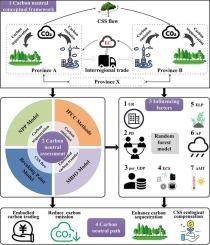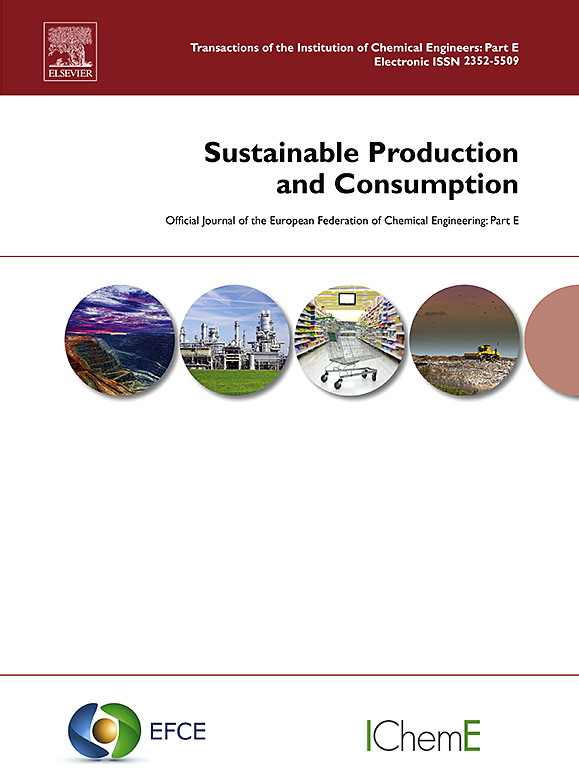Incorporating embodied carbon transfer and sequestration service flows into regional carbon neutrality assessment in China
IF 10.9
1区 环境科学与生态学
Q1 ENVIRONMENTAL STUDIES
引用次数: 0
Abstract
Reliable and effective carbon neutrality assessments are crucial prerequisites for implementing various low-carbon policies and achieving carbon neutrality goals. Although the impact of embodied carbon transfer and carbon sequestration service flows on regional carbon neutrality is becoming increasingly significant, these factors are not effectively incorporated into current carbon neutrality assessments. Based on a thorough review of the literature and theoretical analysis, this study attempts to construct a regional carbon neutrality assessment framework that incorporates embodied carbon transfer and carbon sequestration service flows. This framework is then applied to assess carbon neutrality and its influencing factors in China's provinces. Our findings reveal that carbon emissions and sequestration capacities have increased across Chinese provinces, with the highest emissions in North and East China, and the highest sequestration in Southwest China. Economically developed provinces like Beijing, Zhejiang, and Jiangsu transfer substantial embodied carbon to provinces such as Inner Mongolia, Shanxi, and Hebei, while Guangxi, Sichuan, Yunnan, and Qinghai are major providers of carbon sequestration services. Carbon neutrality levels in Chinese provinces show a ring-shaped distribution, increasing from the inner to outer rings. Higher levels are found in Southwest and Northwest provinces (e.g., Yunnan, Qinghai, Guangxi), and lower levels in North and East provinces (e.g., Shanxi, Beijing, Zhejiang). Factors like urbanization rate, population density, per capita GDP, and energy consumption structure negatively impact carbon neutrality levels, whereas ecological land area and annual precipitation have positive impacts. In summary, incorporating embodied carbon transfer and carbon sequestration service flows into the regional carbon neutrality assessment framework facilitates a more comprehensive analysis of regional carbon neutrality levels and their influencing factors. This approach broadens the theoretical and methodological scope of regional carbon neutrality assessments and provides scientific references for the implementation of low-carbon policies and the advancement of carbon neutrality goals.

将体现碳转移和固碳服务流纳入中国区域碳中和评估
可靠有效的碳中和评估是实施各种低碳政策和实现碳中和目标的重要前提。尽管体现碳转移和碳封存服务流对区域碳中和的影响日益显著,但这些因素并未被有效纳入当前的碳中和评估中。基于对文献的深入研究和理论分析,本研究试图构建一个包含体现碳转移和碳封存服务流的区域碳中和评估框架。然后将该框架应用于评估中国各省的碳中和及其影响因素。我们的研究结果表明,中国各省的碳排放量和碳封存能力都有所提高,其中华北和华东地区的碳排放量最高,西南地区的碳封存能力最高。北京、浙江和江苏等经济发达省份向内蒙古、山西和河北等省份转移了大量的体现碳,而广西、四川、云南和青海则是碳封存服务的主要提供者。中国各省的碳中和水平呈环状分布,由内环向外环递增。西南和西北省份(如云南、青海、广西)碳中和水平较高,华北和华东省份(如山西、北京、浙江)碳中和水平较低。城市化率、人口密度、人均 GDP 和能源消费结构等因素对碳中和水平有负面影响,而生态用地面积和年降水量则有正面影响。总之,将体现碳转移和碳封存服务流纳入区域碳中和评估框架,有助于更全面地分析区域碳中和水平及其影响因素。这种方法拓宽了区域碳中和评估的理论和方法范围,为实施低碳政策和推进碳中和目标提供了科学参考。
本文章由计算机程序翻译,如有差异,请以英文原文为准。
求助全文
约1分钟内获得全文
求助全文
来源期刊

Sustainable Production and Consumption
Environmental Science-Environmental Engineering
CiteScore
17.40
自引率
7.40%
发文量
389
审稿时长
13 days
期刊介绍:
Sustainable production and consumption refers to the production and utilization of goods and services in a way that benefits society, is economically viable, and has minimal environmental impact throughout its entire lifespan. Our journal is dedicated to publishing top-notch interdisciplinary research and practical studies in this emerging field. We take a distinctive approach by examining the interplay between technology, consumption patterns, and policy to identify sustainable solutions for both production and consumption systems.
 求助内容:
求助内容: 应助结果提醒方式:
应助结果提醒方式:


